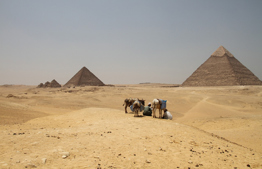Parashat Noach: Can an exceptional event actually rectify the situation?

Do extraordinary, miraculous events have a long-lasting effect? On the role of the extraordinary and the mundane, and the connection to the mitzvot hatelyuot ba’aretz. Also a few words on kilei hakerem and Kefar Aziz.
וַיֹּאמֶר ה' אֶל לִבּוֹ: לֹא אֹסִף לְקַלֵּל עוֹד אֶת הָאֲדָמָה בַּעֲבוּר הָאָדָם, כִּי יֵצֶר לֵב הָאָדָם רַע מִנְּעֻרָיו, וְלֹא אֹסִף עוֹד לְהַכּוֹת אֶת כָּל חַי
כַּאֲשֶׁר עָשִׂיתִי; עֹד כָּל יְמֵי הָאָרֶץ, זֶרַע וְקָצִיר וְקֹר וָחֹם וְקַיִץ וָחֹרֶף וְיוֹם וָלַיְלָה, לֹא יִשְׁבֹּתוּ
And the L-rd said to Himself: “Never again will I doom the earth because of man, since the devisings of man’s mind are evil from his youth; nor will I ever again destroy every living being, as I have done.So long as the earth endures, seedtime and harvest, cold and heat, summer and winter, day and night shall not cease.” (Bereishit 8:21-22).
Can an exceptional event actually rectify the situation?!
Many things have been said in denigration of routine. It's tiring, boring, and burns us out. How happy are we when there is finally a holiday or a family simcha that elevates us a few inches above the ground. In contrast, and while we obviously do not look forward to such events, at times even a sad or painful occurrence breaks up the routine as well.
In a way, outstanding events, both uplifting and catastrophic, are similar in that they force us out of our routine. It is widely believed that such outstanding events can act as a catalyst to speed up processes and bring about a solution to problems that bog people down in the gray days of routine. Is this true? An inspection of several such events leads us to the conclusion that this is not necessarily the case.
The Revelation at Sinai is a case study—an event etched into the national consciousness of the Jewish People and humanity at large. G-d, in all of His glory, reveals Himself to an entire nationin an unprecedented fashion, with no second. And then all but 40 days pass and the nation sins with the Golden Calf. So if we thought that the situation of "those are idol worshippers and those are idol worshippers," describing the Jewish people in Egypt, had fundamentally changed—we would be wrong. Even the intense three-month period since the Exodus from Egypt, accompanied by blatant miraculous events, did not have the power to uproot deep-seated issues of faith. Not even the Revelation at Sinai.
This is true of our parasha as well: the world became so corrupt that there was no hope to rectify it other than near total annihilation. Yet, when G-d promised that He will never again bring another deluge (or in other words, turning natural order on its head), He did not say that this is because the Flood actually rectified the world, but rather "since the devisings of man’s mind are evil from his youth." That is, a one-time purification (either through a joyous or catastrophic event) will not change the baseline, since man has an evil inclination. After experiencing the extraordinary event, the evil inclination will continue to be active, and it seems, on the face of it, that nothing has been gained.
Evolution, Not Revolution
In light of the above, should we give up on fixing man and society? Of course not! However, the solution is not a revolution, rather evolution. We can chip away at the boulder called the evil inclination, but it is a slow process that can be accomplished precisely during the routine. The evil inclination is willing to leave alone during Yom Kippur so that he can begin operations full force the minute the fast is out. However, it is precisely the actions we do every day that can elevate and sanctify us, and it is these actions that have the power to truly rectify the world.
If all this is true, then what is the purpose of the events that break up our routine? The goal of these events is to provide us with a vision, to pave a path, and to give us direction. In the case of a natural disaster, such as the Flood, it is even to punish those who have become so corrupt that they have passed the point of no return. Later on, when we come back to our routine, we need to slowly bring down the huge revelation of G-d's hand (which is present in any exceptional event, whether the Revelation at Sinai, or the Flood) so it can penetrate our souls, in the form of good deeds done consistently, every day. These everyday actions have the power to actually help us change.
The mitzvot linked to the Land of Israel are an excellent example of these two types of events. On the one hand, most of these mitzvot are the "boring" routine mitzvot, rooted deeply in the world of agriculture, with the repetitive cycle of planting-harvest/summer-winter, which continues ad infinitum. Then there are the Land-linked mitzvot that break up the routine, such as shemita and yovel, which occur once every so often. Another "exceptional" mitzvah is bikurim, which is an especially joyous event that takes man out of his field and vineyard and takes him—with pomp and circumstance—to the Beit Hamikdash. There he declares while reading the text of parashathabikurim that he recognizes that it is the Master of the Universe Who is responsible for all of his material success. While these exceptional mitzvot are not sufficient to essentially change people, they provide direction and vision, while the other usual, everyday mitzvot slowly but surely effect this lasting change.
The Trellised Grapevines of Kefar Aziz
מעשה שהלך ר' יהושע אצל ר' ישמעאל לכפר עזיז והראהו גפן מודלה על מקצת תאנה. אמר לו: מהו להביא זרע אל תחת המוֹתר? אמר לו: מוּתר. והעלהו משם לבית המגניה והראהו גפן שהיא מודלה על מקצת הקורה וסדן של שקמה ובו קורות הרבה. אמר לו: תחת הקורה זו אסור והשאר מוּתר
There was an incident that Rabbi Yehoshua went to Rabbi Yishmael to Kefar Aziz, and he [Rabbi Yishmael] showed him a vine that was suspended over part of a fig-tree. He said to him [he asked Rabbi Yehoshua], "May I bring seed under the rest?" He [Rabbi Yehoshua] said to him, "It is permitted," and he took him up to Beit Hamaganya, and he showed him a vine suspended over part of a branch [beam] of a sycamore tree, which had many branches. He [Rabbi Yehoshua] said, "Under this it is prohibited, and [under] the rest is permitted.(Mishna Kila'im 6:4)
Trellising onto fruit trees and non-fruit trees
The prohibition against kila'im, interplanting, includes several categories, the most severe of them being kilei hakerem, interplanting with grapevines; the fruit of kilei hakerem are not only prohibited for consumption, but even for benefit. Kilei hakerem becomes an issue when an annual plant is sown next to a grapevine or under one of its trellised branches. Trellising grapevines onto the branches of a tree is not prohibited in and of itself. However, when it is a tree that does not bear fruit (or any trellising apparatus [termed an afifirot], a cord or artificial branch meant for trellising), it is forbidden to plant annual produce under the branch onto which the grapevine is trellised; even planting under the tree's other branches, where the grape is not trellised, is forbidden. The reason for this is that when the tree is not a fruit-bearing tree, people don't care about turning the tree into a support for a grapevine. This is why even the branches that the grapevine's shoots haven't reached are considered designated as a trellis, and so annuals cannot be planted beneath them. If annuals are sown beneath these branches, and the grapevine reaches the part above these plants, both the grapes and annual produce beneath it becomes forbidden, in keeping with the laws of kilei hakerem.
However, in the case where a grapevine trains itself onto the branches of a fruit tree, while it is prohibited to plant beneath the branches where the grapevine is trellised, it is permissible to plant beneath the other branches of the tree. The reason for this difference between fruit and non-fruit bearing trees lies in the assumption that while people do not care about turning their non-fruit bearing tree into a trellis for a grapevine, "a person does not nullify his fig tree to his grapevine." That is, people do not give up on the use of their fig tree as a fruit-bearing tree and allow the tree to be suffocated or stop bearing fruit just to serve as a trellis for a grapevine. For this reason, the rest of the tree's branches are not considered to be designated as a trellis.
If seeds were planted beneath other branches of a fruit tree, and later the grapevine spreads to the branches above the plot sown, the grapevine should be trained to an area that is not above the sown area; neither the fruit nor the planted produce is forbidden. Note that there is only an issue of kilei hakerem when annual produce is planted beneath the grapevine; a grapevine trellised onto a fruit tree is not problematic in and of itself.
In the case of R' Yehoshua who came to Kefar Aziz to visit his student R' Yishmael, a local resident, who presented R' Yehoshua with two cases. The first was the classic case of the grapevine trellised onto a fruit tree, in this case a fig tree. R' Yishmael asked if it would be permitted to plant beneath the motar, that is, underneath the part of the branch that the grapevine hadn't yet reached. R' Yehoshua's answer was, of course, that this would be permitted.
From there, R' Yehoshua was taken to a place nearby (which was apparently higher up, which we know from the terminology he'elahu, "he brought him up"), and his student asked R' Yehoshua about the grapevine trained onto a branch where nearby was a sycamore tree (whereas the branch or beam was not connected to the sycamore tree; this is according to the understanding of Rabbi Yosef Kapach on the Rambam in his commentary on this mishna), while there were branches sprouting from the sycamore tree. The law for this external branch is the same as for any trellis apparatus and non-fruit bearing tree: it is prohibited to plant underneath the motar. However, for the sycamore tree the rule is different. A sycamore tree is considered a fruit tree (according to the Rambam), even though its primary use is its branches, since it does actually bear edible fruit. For this reason, it would be permitted to plant underneath it branches where the grapevine has not yet reached, just like the ruling for any other fruit tree.
Kefar Aziz is identified as Hurbat Aziz, close to Yata. It is said that R' Yishmael lived next to Edom, and this area in Second Temple times was called Edomi'a, since Edomites settled the area following the destruction of the First Temple. It is possible that the location of Kefar Aziz in the South Hevron Hills is also considered adjacent to the Biblical Edom, east of the Arava.
The area was not excavated, however in an archeological survey taken of the area following the Six Day War wine presses and burial caves were discovered with Jewish identifying features. These areas date even after the Bar Kochba Rebellion, which indicates that the settlement was able to rehabilitate itself following the failure of the rebellion, which dealt a crippling blow to Jewish settlement in Judea. A large structure was discovered in the area, identified by David Amit as a church (due to its shape and crosses found there and in its immediate vicinity). We can learn from this that the Jewish settlement from the Mishnaic period and the early Talmudic period was taken over by Christians who ruled the Land of Israel during the Byzantine era.
The location and character of Beit Megina are unknown. Some believe that it is an area adjacent to Kefar Aziz or the name of a family that lived there. Others associate the name with hagana, protection; perhaps this was a system of secret caves that were and still are in Kefar Aziz, still present throughout the South Hevron Hills.




